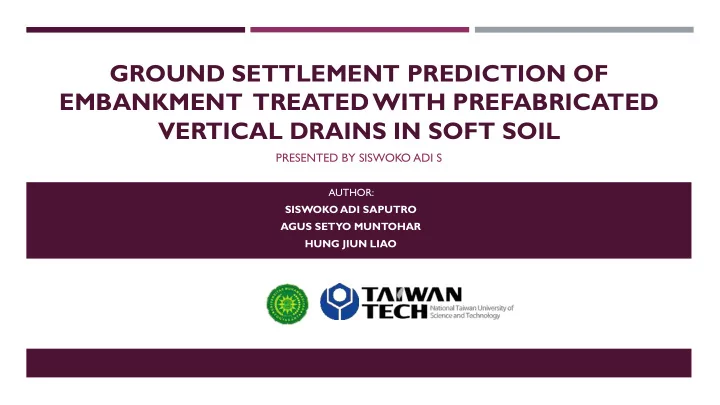

GROUND SETTLEMENT PREDICTION OF EMBANKMENT TREATED WITH PREFABRICATED VERTICAL DRAINS IN SOFT SOIL PRESENTED BY SISWOKO ADI S AUTHOR: SISWOKO ADI SAPUTRO AGUS SETYO MUNTOHAR HUNG JIUN LIAO
CONTENT GEOTECHNICAL SITE CONDITION GROUND IMPROVEMENT LAYOUT METHODOLOGY RESULT AND DISCUSSION CONCLUSION
GEOTECHNICAL SITE CONDITION The study case was taken from Ahmad Yani airport expansion project in Semarang, 2012-2013. SP-14 SP-13 SP-15 The soil investigation was done by: BM 3 BM 4 1. Standard Penetration Test (SPT) at 6 points with 30 m depth. (BM-01 to BM- 06) 2. Cone Penetration Test (CPT) which was conducted at 23 points with 25-28 m depth variation (S1 to S23) 3. laboratory test such as of soil However, the location that we want to study is focus on A-A cross properties, soil strength, as well section in dash red square. consolidation
SOIL LAYER (A-A CROSS SECTION) In this study, the soils that we want to simulate are borehole BM-03 and BM-04. Very Soft Based on the figure, the simulation result will be compared with the field measurement from SP-13, Sp- Soft 14 and SP-15 because the settlement plate location is Stiff Clay nearby the borehole location with assumption that the Very Stiff Clay model has same condition with the actual condition.
GROUND IMPROVEMENT LAYOUT The embankment was built in 5 meter height with one third slope whether PVD were installed in triangular pattern with 1.2 meter spacing. Some instrument such as inclinometer, piezometer, and settlement plate were installed to monitor the soil condition and to obtain the daily ground settlement.
METHODOLOGY ASAOKA METHOD
NUMERICAL METHOD Start PLAXIS 2D Input Soil Model Data, Soil Properties, Embankment, PVD Modified Cam-clay Spacing, etc No Different Coef. of Permeability Ratio (k ve /k v ) Soil Settlement Behavior Set-up the Stage Yes Run the Model END Construction compare to Actual Data
SOIL PROPERTIES (MODIFIED CAM-CLAY)
PVD PROPERTIES EQUIVALENCY
STAGE CONSTRUCTION
NUMERICAL MODEL (MESHED)
RESULT AND DISCUSSION SP-13, SP-14 and SP-15 data is Very Soft used to make comparison between actual data and numerical analysis Soft Stiff Clay Very Stiff Clay
NUMERICAL RESULT The model in PLAXIS 2D were build with different coefficient of permeability (k) ratio which done by trial error. Coefficient of Permeability Ratio (k ve /k v ) 0.1 0.5 1 2
GROUND SETTLEMENT BEHAVIOR SP-13 SP-13 RMSD for each ratio: Ratio 0.1 = 106.6 Ratio 0.5 = 57.7 Ratio 1 = 405.7 Ratio 2 = 187.5
GROUND SETTLEMENT BEHAVIOR SP-15 SP-15 RMSD for each ratio: Ratio 0.1 = 146.4 Ratio 0.5 = 34.5 Ratio 1 = 566.8 Ratio 2 = 213
GROUND SETTLEMENT BEHAVIOR SP-14 SP-14 RMSD for each ratio: Ratio 0.1 = 107.6 Ratio 0.5 = 163.6 (BM-03) Ratio 0.5 = 77.5 (BM-04) Ratio 1 = 584.5 Ratio 2 = 89.1
RMSD (ROOT MEAN SQUARE DEVIATION) T o evaluate the result of ground settlement behavior, the RMSD was analyzed to know which model has lower error from RMSD value. The model with ratio 0.5 has lower RMSD for all settlement plate (SP). Except for SP-14 which has soil characteristic more closely to borehole BM-04 (refer to Fig.1 and Fig. 2). The model of SP-14 has closer result with actual when the model used the soil parameter from borehole BM-04.
ASAOKA METHOD RESULT SP-13 Final settlement Actual = 1637 mm Analysis = 1654 mm Error ratio = +1.0%
SP-14 Final settlement Actual = 1860 mm Analysis = 1885 mm Error ratio = +1.3%
SP-15 Final settlement Actual = 1701 mm Analysis = 1710 mm Error ratio = +0.5%
FINAL GROUND SETTLEMENT Soil Settlement Final Settlement (mm) Properties Plate Asaoka Numerical Actual BM-03 SP-13 1654 1580 1634 BM-03 1885 1575 1860 SP-14 BM-04 1917 BM-04 SP-15 1710 1746 1701
CONCLUSION Asaoka (Observation Method) shows almost perfect proximity to field measurement because the availability of complete observation data The ground settlement behavior simulated using finite element analysis produce the closest to the field measured data when the permeability ratio (kve/kv) is equal to 0.5. The coefficient of permeability plays crucial role in estimating the consolidation rate and settlement behavior of the soft clayey soil in this numerical analysis. Hence, the soil parameter plays a significant rule and is very sensitive in this numerical analysis
“If We Knew What It Was We Were Doing, It Would Not Be Called Research” --- Albert Einstein ---
Recommend
More recommend